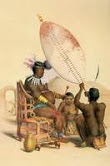The idea of African stupidity and ignorance was pumped into my educational package which comprised western racist depiction of Africans as sub-human, incapable of intelligent enterprise and physically only fit to be used like cattle or as servants to white men and women. I vividly remember how my classmate in Amsterdam once looked at me in surprise when I told her I saw myself as Surinamese and not as Dutch. Her answer still rings in my ears, 'but you speak Dutch so fluently" implying how could you be Surinamese if you speak Dutch so well. The cultural awareness of a 15 year old black girl in the Netherlands before independence and before the revolution was basically colonial.
My father pointed out to me what independence and decolonization meant for Suriname by being a political activist in the Party National Republic which opposed Dutch colonialism in the sixties and seventies of the 20th century. My parents also taught me about their love for Suriname when they sang for me and my sisters. 'Sranan mi kondre abra watra, mi lobi mi lobi yu fu tru'. Suriname my country overseas, I love you, I truly love you.
The mirrors and beads which were a history book item for me have today come alive in a different way. They have become a matter of recognition of African history before colonialism invaded the continent and destroyed whole generations and depleted vast areas of west African territory of its population.
The beads suddenly come back to life as authentic and legitimate elements of African culture and civilization long before a white colonial greedy trader ever used beads to buy slaves.
As it turns out Africans from the North to the South of the continent have used beads as valuable objects to pay for goods or to decorate themselves or as ornaments.
 The Egyptians used metal coins and beads made of bone and glass and later the famous Venetian beads with the floral patters also known as mille fiori were accepted forms of payment and are even today considered highly valued treasures. Traders in African markets today still sell colorful glass beads.
The Egyptians used metal coins and beads made of bone and glass and later the famous Venetian beads with the floral patters also known as mille fiori were accepted forms of payment and are even today considered highly valued treasures. Traders in African markets today still sell colorful glass beads.
The idea of western commerce as the seat of civilization is no longer valid but it must be said that the boost in glass bead production in Italy and England had much to do with slave trade and the way slave traders paid for their human cargo. The large quantities of beads were used as ballast in slave ships and used to trade with Africans. The culture which considered beads a treasure was trading its people for beads. The mirrors which linked humans with that other magical spiritual world were used to trick aristocrats into arms deals. The African continent still feels the aftermath of this beads and mirrors trading era in which western traders made good use of cultural values of African leaders and traded beads for people . The beads were not so silly after all, the value of mille fiori glass beads in African history is immeasurable. African royals who wore the expensive beads and adorned their homes with precious beads have paid a high price.
Today the cultural and political awareness of a descendant of Africans who were transported to the Americas is raised a little by information found about the rich and influential bead history of many nations on the African Continent. More information about African Trade beads can be found on the website: www.ezakwantu.com
Today the cultural and political awareness of a descendant of Africans who were transported to the Americas is raised a little by information found about the rich and influential bead history of many nations on the African Continent. More information about African Trade beads can be found on the website: www.ezakwantu.com






Geen opmerkingen:
Een reactie posten